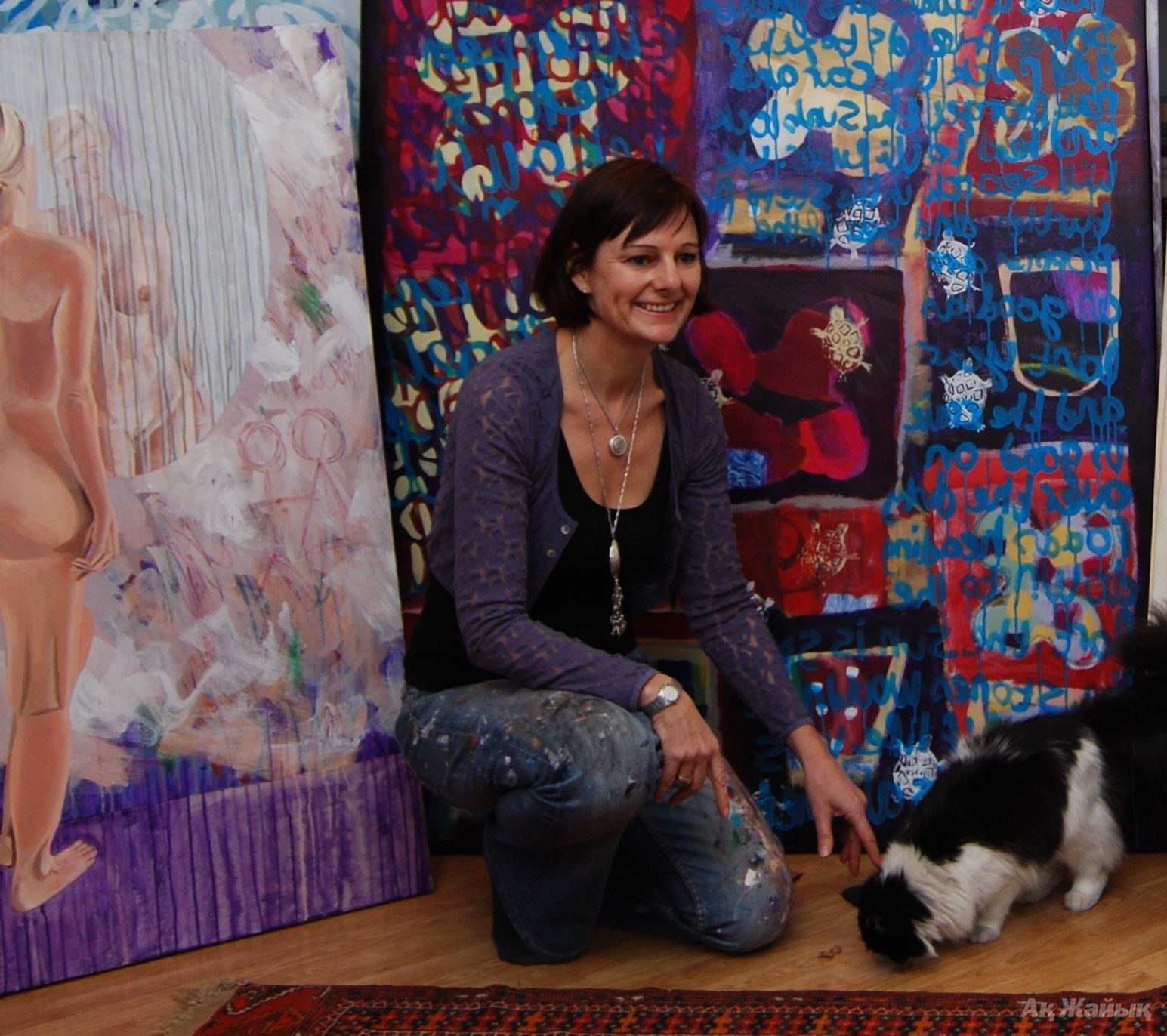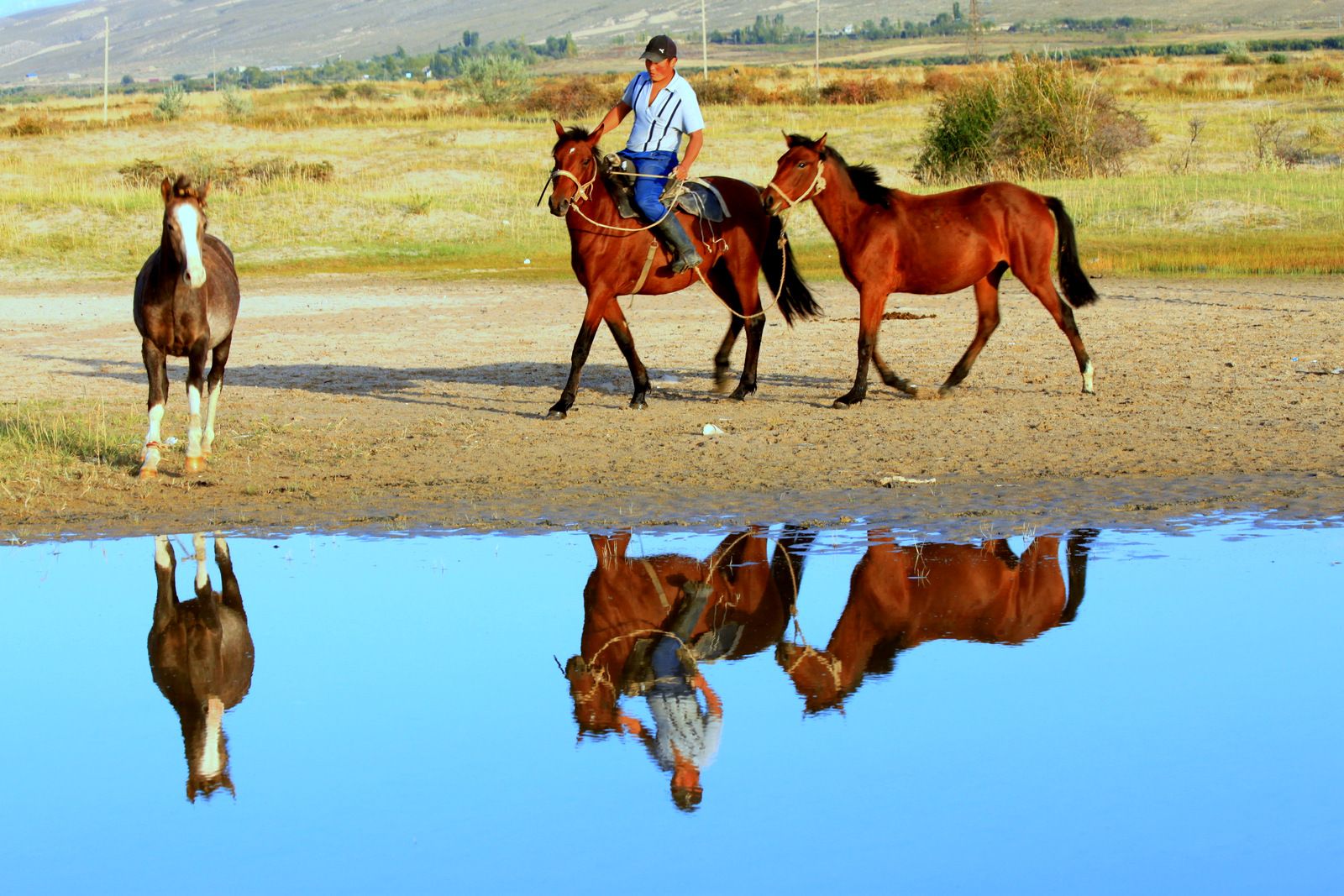By Zeena Urynbassarova
 Mary O'ConnorFrom the soaring mountain peaks to the lonely desert landscapes, from the people and places to the textures and tastes, acclaimed Irish artist Mary O’Connor has got behind the lens to capture the spirit of Central Asia. The result is “Head Over Heels” , a new book of mind-blowing photographs that takes you on a journey down the Silk Road, winding through the entrancing lands of Kazakhstan, Kyrgyzstan and Uzbekistan. (Joanna Lillis, writer).
Mary O'ConnorFrom the soaring mountain peaks to the lonely desert landscapes, from the people and places to the textures and tastes, acclaimed Irish artist Mary O’Connor has got behind the lens to capture the spirit of Central Asia. The result is “Head Over Heels” , a new book of mind-blowing photographs that takes you on a journey down the Silk Road, winding through the entrancing lands of Kazakhstan, Kyrgyzstan and Uzbekistan. (Joanna Lillis, writer).
Mary O’Connor was born in Wexford, Ireland. She studied design in Dublin and has been practising as a contemporary artist since 2000. In 2003 Mary followed her engineer husband to Almaty, Kazakhstan, where she now lives. In recent years she has also pursued photography.
I contacted Mary over e-mail and had a pleasure of getting to know her better.
- Mary, please tell me about yourself, your family and your home town.
- I grew up in a town called Wexford by the sea, on the sunny south east coast of Ireland. Wexford has a famous Opera Festival and every October, for as long as I can remember, the town was full of artistic people. This had a big impact on following my career path as an artist. I have one sister and four brothers, so I came from a large Irish family. My parents had their own law practice which has been a family business for four generations. They are very community orientated people, getting involved with sport and the arts, that’s where I get these desire to help children from. My father founded our local Rugby Club 50 years ago.
- You started your career as interior designer. Why have you started painting and then did photography?
- I have always wanted to paint. When I paint I am at my happiest. My paintings reflect a deeper response to the place I have lived for the past 10 years. The urban and rural environments are very important to my creative being. How I started doing photography? To be honest, I can only say that it was like magic, how one event led to the next to make this book happen. Building a portfolio of beautiful photographs with such inspiring nature, cities, history, and above all people was a labour of love.
‘EARTHINESS’ AND SPIRITUALITY
 Owl. Photo by Mary O'Connor- Turkic world and nomadic culture… What immediate associations do you have with those words?
Owl. Photo by Mary O'Connor- Turkic world and nomadic culture… What immediate associations do you have with those words?
- I feel there is an ‘Earthiness’ and spirituality with these words, and it gives me a feeling of being connected with the land. Survival, Family and being down to earth and everything that is associated with this. I also think of openness and vastness in terms of the size of the land here and its small population.
- During 10 years that you lived and travelled in Central Asia, have you felt the difference between Kazakhs, Kirgiz and Uzbeks in terms of mentality, culture, etc.? What differences do we have and what we have in common?
- Definitely, there are differences, but they are very subtle.
- What changes have you noted during your 10 years in Kazakhstan? What changed and what stayed unchanged?
- I noticed huge changes in a lot of areas, especially, in Almaty. The road infrastructures have advanced, and more traffic by the day. The new roads are built here and then they are filled with cars the next day. Really, its time to get the Metro finished. When my husband and I arrived here, the Financial District did not exist. There were small old houses and back streets, and it looked very local. There was an old Brewery near where we lived which everybody loved, then in 2008 it was knocked down to build the new over-pass. In one way this was sad and in another way it is all progress, I guess. When we arrived, absolutely nobody cycled a bike or pushed a pram, now cycling is so popular. It’s all so amazing. Look at how well Kazakhstan did in the Olympics!!! That’s fantastic. Sadly, the pollution is still the same, and I find it really sad that nobody has built lovely new children’s hospitals in all the major cities. In Almaty, the Centre City is still the same, more or less; it’s so beautiful and full of character. I really wish there was a plan to refurbish many old apartments and buildings in the city.
DESCENT OF HIGH KINGS
- Were there instances when Kazakhs tried to “inaugurate” you into their clans and juzes? In Atyrau I met expats who said they were “inaugurated” into Adai, Sherkesh clans. It is a joke, of course.
- That sounds amazing. Almaty is a big city, and even though I have lovely Kazakh friends I have not had this honour yet. I look forward with pleasure to being accepted into a Kazakh clan. In Ireland I am from one of the most important Clans. The O’Connors were the High Kings of Ireland...so My Kazakh Clan needs to be a good one!
 Reflection. Photo by Mary O'Connor- What are your impressions of the Kazakh art and who are your favorite Kazakh artists?
Reflection. Photo by Mary O'Connor- What are your impressions of the Kazakh art and who are your favorite Kazakh artists?
- I love Kazakh art. Especially, the contemporary art. I also love the textiles, the Tuskiiz from Kazakhstan, the Felt from Kyrgyzstan and the Suzanis from Uzbekistan. You have some excellent artists here. My favorite Kazakh artist is Marat Bekeev. I have included him into my book. Laline Traheen Pollock, one of the writers, interviewed him. His creativity reflects what I feel about your nomadic culture, as I explained above. I also really admire some more contemporary artists and the sculptor Eduard Kazaryan. Of course, there are excellent art from the old days, however, I love contemporary art most of all. I visited Nukus city Museum in Karakalpakstan (which is part of Uzbekistan). This is a gem of Central Asian and Russian Culture. Everybody should go there, see this art and learn this history.
- Is there any similarity between Ireland and Kazakhstan, between Irish people and Kazakhs?
- There are, indeed, a lot of similarities, that’s why I have been happy to live here so long. Both in Ireland and Kazakhstan the family is very important. That’s the main thing. Also, there are similarities in the way we think. I feel that both countries think in a sort of a creative way and go about our business like this. Another similarity is that we are the countries that are getting to know ourselves again and re-visiting our forgotten cultural heritage, because we were both occupied by another country. This is a very exciting situation and time for a country. Because of all this I feel that I identify myself with Central Asia.
EAST OR WEST
- Your book is called “Head over heels” meaning that we live in different worlds. What major differences do we have: West and East?
- I called the book “Head over Heels” for two reasons. Firstly, there are a lot of opposites between here and there. For example, running around in bare feet outside is seen here as something really dangerous to do, as you may get ill, catch a cold or something. In Ireland this means you are strong and healthy and will never catch a cold! After shopping here the cashier here always asks us for the exact change, this never happens in Europe, the cashier is supposed to have the change. Lots of silly things like this. And, secondly, I have fallen Head over Heels in love with Kazakhstan, meaning that I really like it here now, which I did not believe would happen when I came here first.
- I know that Irish people love singing and dancing. Do you sing or dance?
- Yes, we are famous for that. I think, everybody knows about River Dance Show. Our capital, the city of Dublin, was designated a UNESCO City of Literature in recognition of its cultural profile and international standing as a city of literary excellence. As for me, I love folk songs and do a bit of Irish dancing that I was taught at school as a kid.
GAELTEACHT
- Do you speak Gaelic? Is it a common language in Ireland or is it forgotten? What do you do to revive it?
- I have a few words of Gaelic as every Irish person does. We learn it at school. But it’s like the Kazakh language, was nearly lost. People nowadays are trying to learn it again. In some areas of Ireland, called Gaelteacht, the Gaelic is spoken by everybody all the time. Still English is the most common language for getting, for example, education and other things that are called modern life.
- Have you learnt to speak Kazakh or Russian?
- I know only a few words in Kazakh, and my favorite Kazakh word is Rakhmet (Thank you), but I understand Russian more and can get most things done speaking Russian. I still need to practice and improve my level of general conversation. But that’s my next challenge!
- Have you mastered any local handicrafts?
- I have watched a yurt been made and I have included this into my book. I am very interested in the art of felt making. It’s really beautiful what is made here from felt.
- Can you share with me your future plans?
- To paint more and take more photographs.
All proceeds from Mary’s book will go to the Dara Foundation, an Almaty-based non-profit charity that serves under-privileged children with disabilities.
“I really wanted to use this book to help children in Kazakhstan,” Mary said. “With my admiration for everything that the Dara Foundation does for children, it was a natural partnership. I also wanted to give something back to the people of Kazakhstan and the wider region, who’ve given so much to me”, says Mary.
“HEAD OVER HEELS” IS INITIALLY AVAILABLE IN A LIMITED PRINT RUN OF 800 COPIES, OBTAINABLE FOR A CHARITABLE DONATION AT THE LAUNCHES IN ATYRAU AT:
Renaissance Atyrau Hotel, Wednesday 10 April, at 18:30-20:30 hrs.
 В Атырау +3
В Атырау +3